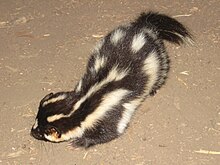Spilogale gracilis amphiala
| Island spotted skunk | |
|---|---|
 |
|
| Scientific classification | |
| Kingdom: | Animalia |
| Phylum: | Chordata |
| Clade: | Synapsida |
| Class: | Mammalia |
| Order: | Carnivora |
| Suborder: | Caniformia |
| Family: | Mephitidae |
| Genus: | Spilogale |
| Species: | S. gracilis |
| Subspecies: | S. g. amphiala |
| Trinomial name | |
|
Spilogale gracilis amphiala |
|
The Channel Island spotted skunk (Spilogale gracilis amphiala) is an insular endemic carnivore and a subspecies of the western spotted skunk (Spilogale gracilis). Little is known about their exact variations from the mainland spotted skunk and variations between locations, resolution of which awaits further genetic and morphologic evaluation. The skunk is only currently found on two islands off the southern coast of California (Santa Cruz Island, and Santa Rosa Island, where its occurrence was once thought to be rare but recently experienced a population surge in the 1990s). Its presence has been recorded on San Miguel Island, but it has since been declared extinct in that area. The Channel Island skunk is one of two terrestrial carnivores on the islands, the other being the island fox. It is designated as a species of special concern by the state of California.
The island spotted skunk is endemic to the Channel Islands off the coast of Southern California. It currently is only found on Santa Rosa and Santa Cruz islands where it is widely distributed. There are previous reports of this taxon living on San Miguel island as well. Record of its inhabitance on San Miguel island ceased after the late nineteen hundreds and it is believed to be extirpated from this region. As of 2011, there were reportedly 3,000 Island Spotted Skunks on Santa Rosa island alone.
The island spotted skunk exhibits habitat preferences similar to those of the mainland species. Its dens have been found in various types of locations including, but not limited to, beneath shrubs, open grasslands, rocky slopes, and beneath the roots of large trees. Difference in habitat preference varied slightly between the two islands. Skunks on Santa Rosa mainly being found in rocky canyon slopes, cactus patches, chaparral, coastal sage scrub, open woodland areas, and riparian habitats along streams. On Santa Cruz Island, skunks are found to prefer chaparral-grasslands, open grasslands, fennel-grasslands, and ravines. Skunks were also found to make dens beneath human dwellings and buildings.
Island spotted skunks show little morphological variation between islands, aside from the skunks found on Santa Rosa Island being slightly longer than those found on Santa Cruz Island. It is distinguished from mainland spotted skunks by its shorter tail with less white ventral coloration (45% white compared to 55% white), slightly larger size, broader skull, and proportionately less white and more black in pelage color. They also tend to have smoother, glossier fur than the mainland variation. It can be identified but an arrangement of white stripes on black fur, running vertically down the back. There are 4-6 stripes and they are usually broken up to give the skunk its “spotted” appearance. The abdomen is white and there is also a small white triangle on the forehead. On average, males tend to be about 23% larger than females.
...
Wikipedia
